 |
|
 |
| |
發行人:林恭如所長 編輯委員:李翔傑教授 主編:林筱文 發行日期:2018.10.30 |
| |
|
 |
|
 本所黃升龍教授榮膺「2019 OSA Fellow」,特此恭賀!
本所黃升龍教授榮膺「2019 OSA Fellow」,特此恭賀!
 本所吳忠幟教授榮膺「美光講座教授(Micron
Chair Professor)」,特此恭賀!
本所吳忠幟教授榮膺「美光講座教授(Micron
Chair Professor)」,特此恭賀!
 本所吳肇欣教授榮獲107年中國電機工程學會「優秀青年電機工程師獎」,特此恭賀! 本所吳肇欣教授榮獲107年中國電機工程學會「優秀青年電機工程師獎」,特此恭賀!
 本所王倫、彭隆瀚、蘇國棟、吳育任、李翔傑等教授,代表本所參加電資學院隊,榮獲「107學年臺灣大學四院教職員工慢速壘球聯誼賽」季軍,特此恭賀!
本所王倫、彭隆瀚、蘇國棟、吳育任、李翔傑等教授,代表本所參加電資學院隊,榮獲「107學年臺灣大學四院教職員工慢速壘球聯誼賽」季軍,特此恭賀!
本所11月份演講公告:
|
日期
|
講者簡介 |
講題 |
地點 |
時間 |
|
光電所專題演講 |
|
11/2
(Fri) |
陳又誠教授
Nanyang Technological University, Singapore |
Bio-Lasers: An Emerging Field Bridging Laser Photonics and Biomedicine |
電機二館
105演講廳
|
14:20~16:00 |
|
11/2
(Fri) |
鄭克勇教授
Electrical Engineering
Dept., National Tsing Hua University |
Evolution
of AlGaN/GaN Heterojunction Bipolar
Transistors |
電機二館
105演講廳
|
16:00~18:00 |
|
11/30
(Fri) |
施上粟教授
國立臺灣大學土木工程學系
|
生態保育與河川治理競合 |
博理館
101演講廳
|
14:20~16:00 |
|
|
 |
|
 |
|
| |
|
 |
|
9月份「光電所專題演講」花絮(花絮整理:姚力琪) |
|
時間: |
107年9月21日(星期五)下午2時20分 |
|
講者: |
陳摘文教授(國立陽明大學神經科學研究所) |
|
講題: |
In vivo imaging of calcium and electrical signals in single hippocampal neurons |
|
|
本所於9月21日(星期五)邀請陳摘文教授於博理館101演講廳發表演說,講題為「In vivo imaging of calcium and electrical signals in single hippocampal neurons」。本所教師及學生皆熱烈參與演講活動,演說內容豐富精彩,與現場同學互動佳,師生皆獲益良多。 |
|
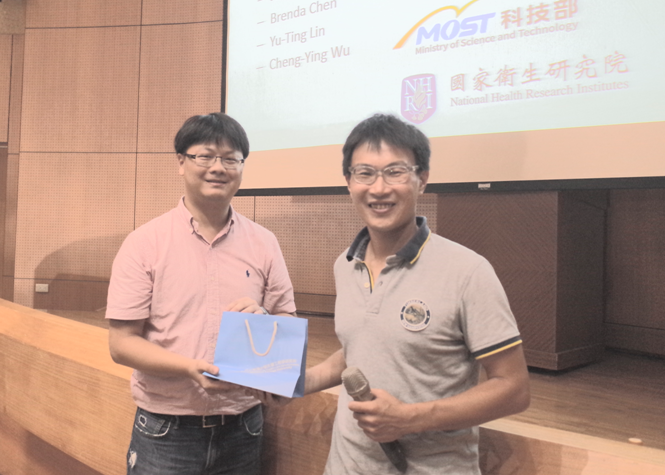 |
|
陳摘文教授(右)與本所李翔傑教授(左)合影 |
|
|
10月份「光電所專題演講」花絮(花絮整理:姚力琪) |
|
時間: |
107年10月5日(星期五)下午2時20分 |
|
講者: |
游佳欣教授(國立臺灣大學化學工程學系) |
|
講題: |
Poly(3,4-ethylenedioxythiophene)-based Bioelectrodes with Designed Chemical and Topographical Cues to Manipulate the Behavior of Neural Cells |
|
|
游佳欣教授於10月5日(星期五)蒞臨本所訪問,並於博理館105演講廳發表演說。游教授應本所李翔傑教授邀請至本所專題演講課發表演講,本次演講題目為「Poly(3,4-ethylenedioxythiophene)-based Bioelectrodes with Designed Chemical and Topographical Cues to Manipulate the Behavior of Neural Cells」。本次演說內容豐富精彩,與現場同學互動佳,師生皆獲益良多。 |
|
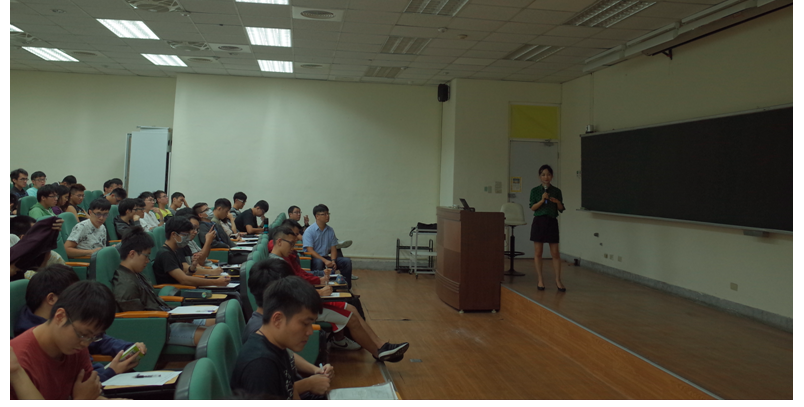 |
|
演講實況 |
|
|
時間: |
107年10月12日(星期五)下午2時20分 |
|
講者: |
楊尚樺教授(國立清華大學電子工程研究所) |
|
講題: |
Advanced Plasmonic Photoconductive Optoelectronics |
|
|
本所於10月12日(星期五)邀請楊尚樺教授於博理館101演講廳發表演說,講題為「Advanced Plasmonic Photoconductive Optoelectronics」。本所教師及學生皆熱烈參與演講活動,演說內容豐富精彩,與現場同學互動佳,師生皆獲益良多。 |
|
|
|
 |
|
楊尚樺教授(左)與本所李翔傑教授(右)合影 |
|
|
時間: |
107年10月19日(星期五)下午2時20分 |
|
講者: |
李明昌教授(國立清華大學電機系暨光電所) |
|
講題: |
Manipulation and Interrogation of Colloidal Microsphere Cavities for Optofluidic Applications |
|
|
李明昌教授於10月19日(星期五)應李翔傑教授邀請蒞臨本所訪問,並於博理館105演講廳發表演說。演講題目為「Manipulation and Interrogation of Colloidal Microsphere Cavities for Optofluidic Applications」。本次演說內容豐富精彩,與現場同學互動佳,師生皆獲益良多。 |
|
|
 |
|
李明昌教授(左)與本所李翔傑教授(右)合影 |
|
|
|
|
|
 |
|
 |
|
| |
|
 |
Wire Electrical Discharge Machined Folded-Up Corner Cube Retroreflector
Professor Jui-che Tsai
Graduate Institute of Photonics and
Optoelectronics, National Taiwan University
臺灣大學光電所 蔡睿哲教授
We have developed an approach to construct a corner cube retroreflector (CCR). A two-dimensional cutout pattern is first fabricated with wire electrical discharge machining process. It is then folded up into a three-dimensional CCR suspended on a cantilever beam. The folded-up CCR may be driven through external actuators for optical modulation; it can also mechanically respond to perturbation, acceleration, etc., to function as a sensor. Mechanical (static and dynamic modeling) and optical (ray tracing) analyses are also performed.
© 2018 SPIE
Yu-Fan Chen, Yen-Hung Wang, Jui-che Tsai, “Study of wire electrical discharge machined folded-up corner cube retroreflector with a tunable cantilever beam,” Opt. Eng. 57(3), 035104 (2018)
Three Dimensional Simulation on the Transport and Quantum Efficiency of
UVC-LEDs with Random Alloy Fluctuations
Professor Yuh-Renn Wu's
laboratory
Graduate Institute of Photonics and
Optoelectronics, National Taiwan University
臺灣大學光電所 吳育任教授
The active regions of ultraviolet light emitting diodes (UVLEDs) for UVB and UVC wavelengths are composed of AlGaN alloy quantum barriers (QBs) and quantum wells (QWs). The use of alloy QBs and QWs facilitates the formation of percolative paths for carrier injection but also decreases carrier confinement within the QWs. We applied the recently developed Localization Landscape (LL) theory for a full 3D simulation of the LEDs. LL theory describes the effective quantum potential of the quantum states for electrons and holes in a random disordered system with a high computational speed. The results show that the potential fluctuations in the n-AlGaN buffer layer, QWs and QBs provide percolative paths for carrier injection into the top (p-side) QW. Several properties due to compositional disorder are observed: (1) The peak internal quantum efficiency (IQE) is larger when disorder is present, due to carrier localization, than for a simulation without fluctuations. (2) The droop is larger mainly due to poor hole injection and weaker blocking ability of the electron blocking layer (EBL) caused by the fluctuating potentials. (3) Carriers are less confined in the QW and extend into the QBs due to the alloy potential fluctuations. The wave function extension into the QBs enhances TM emission as shown from a k.p simulation of wave-functions admixture, which should then lead to poor light extraction. The work is published in Applied Physics Letter.
|

|
|
FIG.1. (a) Illustration of UVC-LED layer
structures. Contacts are put on the top and
bottom surfaces. The simulated device area
is 30nm x 30nm. The thickness of QW and QB
is 2 and 10nm, respectively. (b) Computed Al
compositions in the AlGaN layers obtained by
assuming a random alloy. (c) Emission peak calculated
by averaging 10 different random maps for a
single QW. (d)The band profile of UVC-LEDs
without considering composition fluctuation. |
|
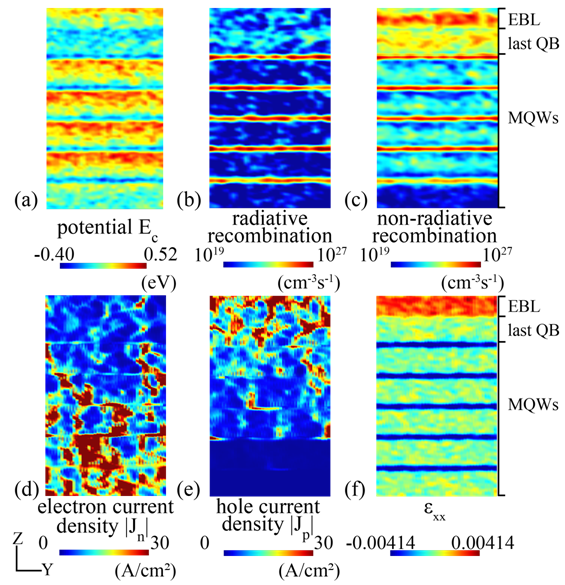
|
|
FIG. 2. Side view of (a) conduction band
potential; (b) radiative recombination rate;
(c) non-radiative recombination rate; (d)
electron current density; (e) hole current density;
and (f)
εxx. All maps at
J=(4.7V,20A/cm2). The z direction
is the growth direction of the epitaxial
stack crystal c-axis. |
|
 |
| |
|
|
|
 |
|
| |
|
 |
論文題目:極紫外光範圍內矽鉬薄膜疊的干涉光譜解析
姓名:黎延垠 指導教授:黃升龍教授
| 摘要 |
|
當製程節點下探7奈米,傳統浸潤式微影術進行多重圖形而造成高昂的成本,將使得極紫外光微影術(EUVL, EUV lithogrpahy)逐漸成為主流。但由於相關光罩檢測工具現在還不被使用,芯片製造商必須依靠晶圓檢測來識別光罩缺陷。基於193奈米的技術在延伸至7奈米方面,因光源波長的繞限極限以及光源的吸收而有所限制。因此,需要檢查工具光源的波長勢必朝向短波長前進。而極紫外光源具有高亮度,穩定性(空間和時間)和成本效益是未來重要的發展方向。
在利用矽鉬多層分光器和反射鏡形成的具有共同路徑的邁克森干涉儀來實現系統的緊實性。基於Wiener-Khinchin定理,通過對測量的信號自相關進行模擬分析而無需波長校準來獲得準確的極紫外光譜。此外,本論文提出了一種非侵入性的共路光學同調斷層掃描術(OCT, optical coherence tomography),其縱向解析度為64.6奈米,用來量測分析矽鉬多層膜鏡的薄膜疊層厚度及其複合傳遞函數。矽鉬疊層的複合傳遞函數在原始的13.5奈米波長範圍內被實驗和模擬驗證。擁有這些知識和成就後,基於極紫外光源的新型光學同調斷層掃描術同時使用雷射產生電漿的極紫外光源和共路設計,顯示出極紫外光源的光學同調斷層掃描術將成為光罩檢測的非破壞性成像方法。
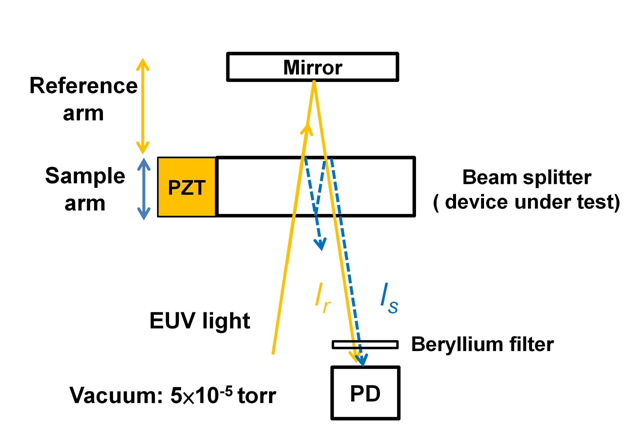 |
|
圖一、共路式極紫外光源同調斷層掃描系統示意圖 |
|
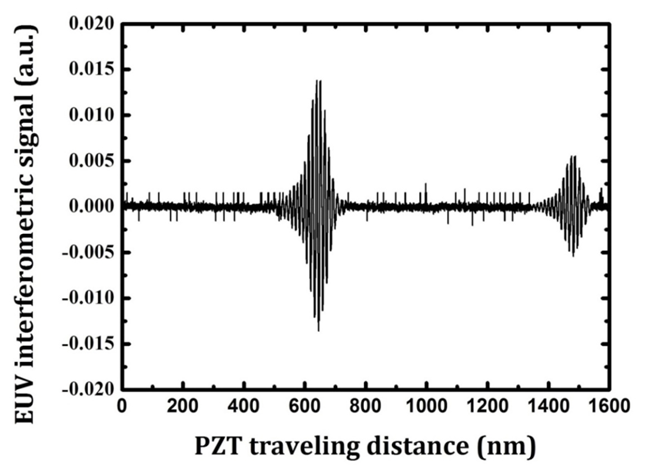 |
|
圖二、量測所得之極紫外光源干涉訊號 |
|
|
|
 |
|
 |
|
| |
|
 |
—
資料提供:影像顯示科技知識平台 (DTKP, Display Technology
Knowledge Platform) —
—
整理:林晃巖教授、盧奕 —
隨選式顯示器
透過多光子吸收的直接雷射寫入(Direct laser writing)已廣泛用於在如玻璃和聚合物的材料中產生三維複雜外觀。在聚合物分散液晶(polymer-dispersed liquid crystals)的背景下,已經可以採用基於雙光子吸收的直接雷射寫入來控制聚合物網絡和液晶元素的折射率之間的交互作用。
現在,學者Chloe Tartan與來自英國和斯洛維尼亞的同事,進一步證實了使用像差校正的直接雷射寫入,在可聚合的液晶裝置中,創造出隨選讀取的微米級圖案(Adv. Opt. Mater. https://doi.org/10.1002/adom.201800515; 2018)。他們的方法是獨特的,因為聚合物微結構直接在可切換的液晶裝置內產生;並且在特定的電壓條件下,聚合物和液晶的折射率也可以匹配,使得聚合物的微結構幾乎看不見。
在他們的研究中,將包含~70wt%向列型液晶主體和~30wt%反應性液晶元以及光敏劑混合物的可聚合液晶混合物,在等向性的液相中以毛細作用填充到液晶盒中。每個液晶盒是由兩個平行的玻璃板組成,玻璃板塗佈了透明導電氧化物(氧化銦錫)和具摩擦刷排的聚酰亞胺對位層。液晶元件安裝在直接雷射寫入系統中的平移台疊層上,並連接到波形產生器,以便在製造期間可以將電場施加至元件上。
當在790奈米(nm)波長具有100飛秒(fs)脈衝寬度且重複率為80百萬赫茲(MHz)的飛秒雷射脈衝通過0.3NA的物鏡入射到液晶裝置上時,光敏劑的雙光子吸收引發反應性液晶元的交聯,從而形成密集聚合物網絡的柱狀結構,這樣的結構使其在暴露於雷射光束時,能鎖定與電壓相關的液晶指向矢分布。自適應光學系統可用於校正由空氣/玻璃界面導致的光學像差,以便可以將微米尺寸的特徵直接寫入液晶元件。雷射寫入的聚合物柱具有1μm直徑和5μm高度的尺寸。
在暴露於直接雷射寫入期間發生的雙光子聚合過程中的非線性特性,確保了液晶分子精確的對準在僅由雷射焦點所限定的小區域周圍“凍結”。透過在直接雷射寫入期間將液晶元件切換到不同的電壓幅度,可以將不同的液晶分子凍結到柱狀結構中。透過使用寫入聚合物結構時的相同電壓幅度來讀取元件,可以使結構外觀消失,因為液晶指向矢分布與周圍區域變得均勻了。透過這種方式,可以將偏振和非偏振光的結構外觀遮蓋掉。當去除電場時,聚合物結構外觀與周圍的液晶區域明顯不同,則可以觀察到圖案。如圖一所示。
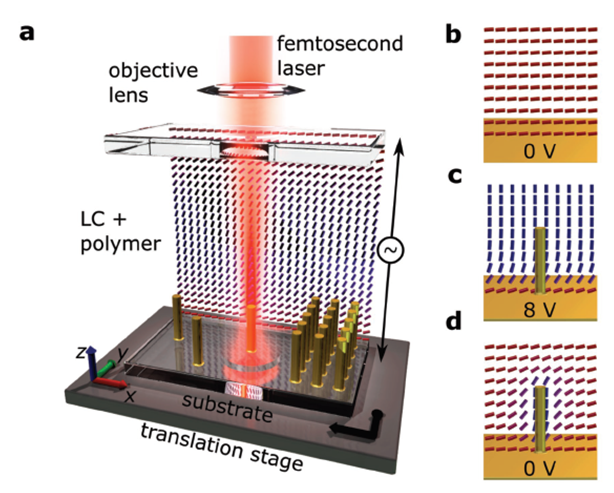 |
|
圖一、在可聚合液晶元件中的雙折射聚合物體的直接雷射寫入。a) 液晶元件中直接雷射寫入過程的圖示。 b) 在沒有施加電壓的情況下,沒有聚合物柱結構的向列型液晶元件的模擬指向矢分布。c) 在施加的寫入電壓Vw = 8V時,聚合物柱寫入元件中時的模擬指向矢分布。d) 去除施加電壓後的模擬指向矢分布。 |
透過輸入適合寫入和讀取的電壓,研究人員已經證明,有可能使聚合物柱在液晶主體中出現和消失。還可以重新配置結構,使得不同的外觀或圖案在不同的電壓幅度下出現。該團隊應用該技術創建微米尺度結構外觀,例如可重新配置的自行車符號,表情符號和快速響應代碼(如圖二所示)。
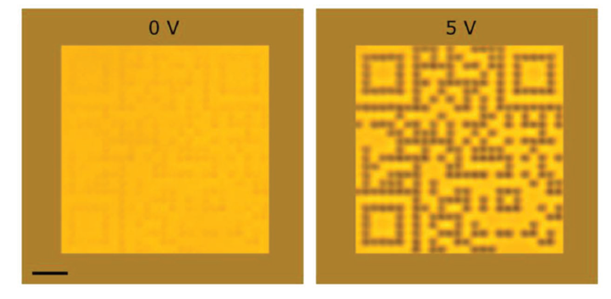 |
|
圖二、以Vw = 0V寫入的快速響應(QR)碼的圖像,柱間距為3μm。 只有當電壓施加到液晶元件時,才能使用智慧型手機掃描代碼。其中比例尺為15μm。 |
英國牛津大學的Stephen Morris向Nature Photonics說:「這種方法的優勢在於,藉由將直接雷射寫入與像差校正的結合,我們可以寫入完全組裝的液晶元件,使我們能夠在微米尺度上創建各種結構和架構,甚至可能在奈米級的解析度,」當被問及他們的未來展望時,他補充說:「我們正在探索使用這種技術可以實現的最小特徵尺寸。這種限制很可能取決於聚合過程中聚合物網絡的擴散,這是我們目前正在研究的問題。」
研究人員發現這種技術在安全、防偽和產品認證方面具有潛力。莫里斯說:「例如,顯示器製造商能使用“浮水印”功能對顯示器進行編碼,這些功能只有在特定電壓配置和序列下才能讀取。」
|
參考資料: |
[1] Rachel Won,“On-demand display,”
Nature Photonics 12, 504 (2018)
https://www.nature.com/articles/s41566-018-0252-y
DOI: 10.1038/s41566-018-0252-y
[2] Chloe C. Tartan, John J. Sandford O’Neill, Patrick S. Salter, Jure Aplinc, Martin J. Booth, Miha Ravnik, Stephen M. Morris, and Steve J. Elston,“Read on Demand Images in Laser-Written Polymerizable Liquid Crystal Devices,”Adv. Optical Mater., 1800515 (2018)
https://onlinelibrary.wiley.com/doi/epdf/10.1002/adom.201800515
DOI: 10.1002/adom.201800515
|
| |
|
|
|
|
|
|
|
|
|
 |
|
 |
|
|
|
 |
|
 |
|